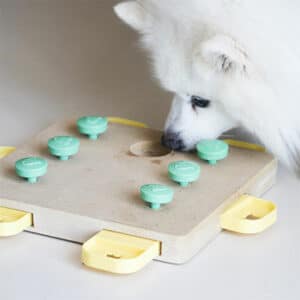In the vast landscape of dog training, there exists a somewhat hidden gem—a skill often underestimated and overlooked—the power of mental stimulation. While many of us focus on the physical aspects of dog training, such as exercise and obedience commands, the mental aspect is equally, if not more, vital. In this comprehensive guide, we will explore the intriguing world of mental stimulation for dogs, unveiling its numerous benefits, sharing effective training techniques, and providing a plethora of resources to enhance your pup’s cognitive abilities.
The Science Behind Mental Stimulation
To truly appreciate the significance of mental stimulation in dog training, let’s delve into some fascinating insights from canine cognitive studies. A few years ago, researchers discovered something remarkable – dogs have a preference for pursuing an item rather than merely receiving it. This revelation hints at a deeper understanding of our furry companions’ minds.
To draw a parallel with human experiences, consider the difference between doing math homework and hitting the gym. Both activities leave us feeling tired, yet they engage distinct aspects of our bodies and minds. Math homework represents the mental challenge, while the gym offers physical exertion. Now, apply this concept to your dog’s daily routine. While taking them for a walk, playing fetch, or engaging in physical activities is undoubtedly beneficial, are you also providing the mental stimulation they crave?

Training Activities for Mental Stimulation
Eye Contact – no cue:
Hold a reward item, such as a treat, to the side until your dog voluntarily looks into your eyes. This seemingly simple exercise serves as an excellent foundation for enhancing their focus and attention.
Sitting for Everything:
Teach your dog that sitting is the new default position. This training technique doesn’t require prompting. Instead, it encourages self-regulation and reinforces discipline. Imagine the profound impact this can have on your pup’s behavior!
Place:
Train your dog to stay on a designated spot or object, such as a mat or cushion. This exercise promotes impulse control and patience—a valuable asset in any dog’s training repertoire.
 Expanding Mental Stimulation: Additional Resources
Expanding Mental Stimulation: Additional Resources
While training activities are a fantastic way to introduce mental stimulation into your dog’s life, you can go above and beyond by incorporating various resources. These resources are designed to challenge your dog’s problem-solving skills and engage their minds in meaningful ways.
- Puzzle Feeders:
Puzzle feeders are ingenious tools that make mealtime an exciting mental exercise for your dog. They come in various forms, from simple DIY options like cardboard boxes or egg cartons to more complex plastic puzzle feeders with flips and buttons. By presenting a food puzzle to your pup, you encourage them to think, strategize, and work for their food—a rewarding endeavor for both you and your furry friend.
- Micro-Routines:
Micro-routines involve incorporating your dog into your daily activities, making them an active participant in your life. For instance, consider cleaning the house with your dog attached to a leash or watching TV with them snuggled up next to you. During these moments, integrate training commands like “Place” or “Stay,” reinforcing their obedience while providing mental stimulation.
- Sensory Experiences:
Engaging your dog’s senses can be an enriching part of their daily routine. Introduce tactile or olfactory stimuli that spark their curiosity and ignite their problem-solving instincts. Here are a few ideas:
- Create a dog-safe garden where they can explore different textures, scents, and sights.
- Set up a designated dig pit with a kid’s sand kit, offering a space for your dog to dig and uncover hidden treasures.
- Provide toys that encourage burrowing or digging, such as puzzle toys with hidden compartments.
Conclusion
In the world of dog training, the role of mental stimulation cannot be overstated. It is the key to unlocking your dog’s hidden potential. By incorporating training activities and resources that challenge their problem-solving abilities, you’ll discover a happier, more fulfilled canine companion. Not only will your dog release pent-up energy in a constructive manner, but you’ll also strengthen the bond between you and your four-legged friend.
As you embark on this journey of mental stimulation, you’ll witness your dog thriving like never before. Their newfound cognitive prowess will enrich their life and yours, making every moment together an adventure of discovery and growth. So, let’s embrace the art of mental stimulation and unleash your dog’s full potential—because a mentally engaged dog is a happy and fulfilled dog.

